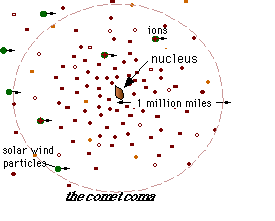Glycine was discovered in a sample from a comet. Glycine is an amino acid. This picture shows four different ways chemists use to show a molecule of glycine.
Click on image for full size
Molecule model images courtesy of Ben Mills.
Stardust Finds Amino Acid in Comet Samples
Scientists have found a type of amino acid in a sample returned from a comet. Amino acids are the building-blocks of proteins. Proteins are one of the most important types of molecules in living creatures. The comet sample was brought back to Earth by NASA's Stardust spacecraft.
Some scientists think that complex molecules might form in space. Some complex molecules, like amino acids, may have helped life get started. Maybe some of the complex molecules formed in space and were brought to Earth on comets. Maybe that's how life on Earth got started. What if complex molecules were carried to other planets, too? Could that help life get started on those planets? We don't know the answers to these questions for sure. That's why finding an amino acid on a comet is important.
The comet that the Stardust spacecraft visited is called Comet Wild 2. Stardust flew by the comet in January 2004. Stardust used a strange material called aerogel to collect material from the comet. The spacecraft actually flew through the comet's thin atmosphere. Scientists at NASA led by Dr. Jamie Elsila found the amino acid in the comet samples. The amino acid they found is called glycine. It is the simplest kind of amino acid.
You might also be interested in:

In the warm early ocean, large molecules came together into a form called *coacervates*. Molecules such as these will form coacervates in the same way that beads of vinegar in oil come together. These
...more
The first beings were probably much like coacervates. As a group, these bacteria were heterotrophic , meaning that they ate food which came from somewhere else. Because there was virtually no oxygen in
...more
Stardust is the name of a space mission that studied a comet. Stardust flew very close to the comet in January 2004. It took some very good pictures of the nucleus of the comet. It also grabbed some dust
...more
Comet Wild 2 is named after the scientist who discovered it. Paul Wild is an astronomer from Switzerland who discovered the comet in January 1978. Wild 2 is pronounced "Vilt 2". It takes the comet a little
...more
The pictures on this page show the nucleus of a comet. These are the best pictures ever made of the nucleus of a comet. The nucleus of a comet is a big lump of ice and dust. This one is about five kilometers
...more
As the ices of the comet nucleus evaporate, they expand into a large cloud around the middle part of the comet. This cloud, called the coma, is the atmosphere of the comet. It can extend for millions of
...more
Scientists have found a type of amino acid in a sample returned from a comet. Amino acids are the building-blocks of proteins. Proteins are one of the most important types of molecules in living creatures.
...more














